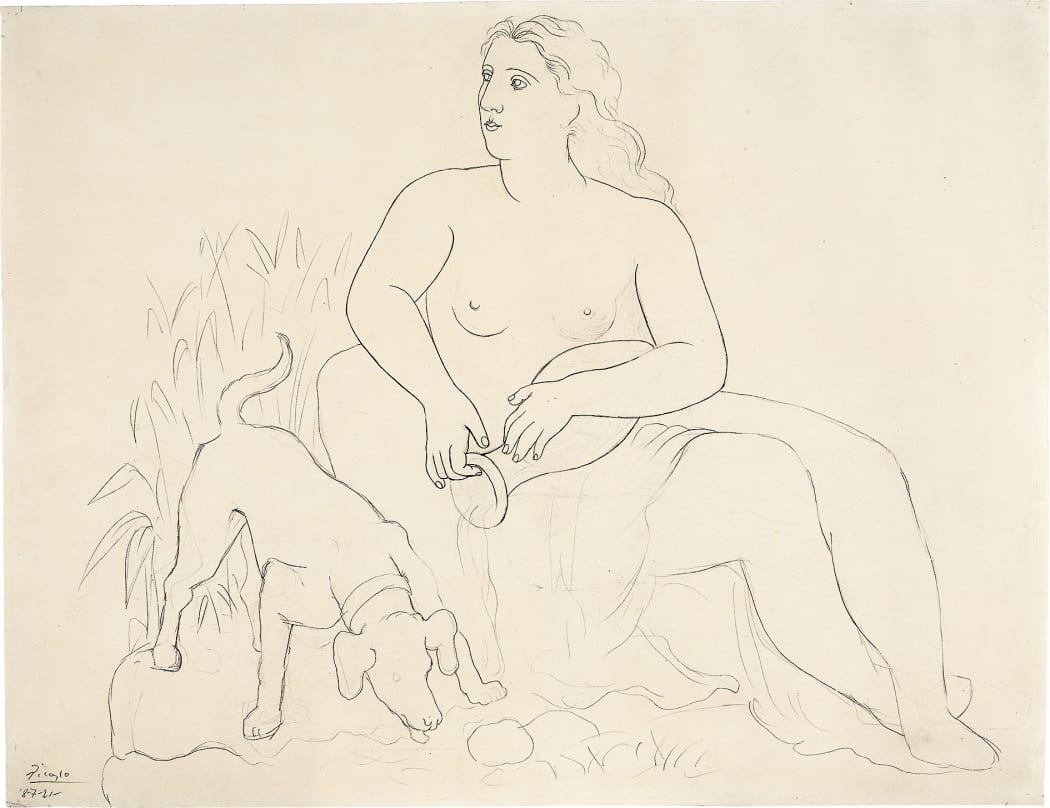
It was 1917 and Picasso had been in Italy for ten weeks, working on the production and set design of Parade, his collaboration with the dancer Massine, the composer Satie, the producer Diaghilev, and of course, his friend Cocteau. He wandered the museums lined with Old Masters in Rome, saw folk dancing and Pulcinella masks in Naples, and in the evenings, he watched the meticulous ballerinas of the Ballet Russes – delicately, staunchly formal, beautifully distinct from the anarchically artistic world he had been inhabiting. There was war in Europe, revolution in Russia, but for Picasso there was the stage and on it, there was only Olga.
Olga Khokhlova was a subdued beauty with dark red hair and wide, melancholically green eyes. She was from a middle-class Russian family and had paved her way on her natural athleticism, the grace of her pointe – though she was not born with wealth, she was born to bear it. She was quite different from the women Picasso had known in Barcelona and Paris – Rosita del Oro and Fernande Olivier, among them. After a show, he’d knock on the door of her stage room, and quietly, she’d deny him entry. For Olga, it was improper to be alone together; for Picasso, Olga’s classicism, her propriety, was tantalizing. The kind of courtship she had in mind had to begin with marriage, not end with it.
After the ballet production concluded, Picasso returned to Paris (along with Olga, who, of course, took up a separate residence) – but he did not return to the allégro of his Parisian life. His old friends had planned a banquet in celebration of his accomplishment, but the date clashed with a dinner party invitation from Diaghilev. Picasso, attentive to his manners, attended Diaghilev’s high-profile event. The decision earned Picasso a scolding note from his snubbed friends: “We, the undersigned, have come together at Henriette’s humble Montparnasse adobe –” (Monparnasse being the new seat of the modernist’s Parisian Bohemia) “– for the Picasso dinner regret that serious business has kept him apart from those who desire his presence and feel they alone deserve it.”*
But those that desired Picasso’s presence were a growing group, and for his part, Picasso desired Olga’s presence – an inherently divisive feeling in his social circles, for Olga did not fit in with his old bande, nor did she very much approve of Picasso’s continued relation with them. He did not mean his relationship to be a slight to his friends, but to be a step toward his future. Picasso, an artist constantly in personal and stylistic evolution, was ready for a new phase. Domestic life, life with Olga, would mean a proper household, a new form to life. He married her in the summer of 1918 – his old world, Apollinaire and Max Jacob, were his witnesses; Cocteau, his new one, was Olga’s.
His alignment with Cocteau and then with Olga (and Apollinaire’s death, which occurred months after the wedding) ushered in a stylistic turn away from Cubism and toward a developing style, which would come to be called his neoclassical period. As in his well-articulated subject Femme au chien (1921), his figures became more monumental, resembling the statuesque forms of antiquity. In 1921, settled into a home with Olga, their first son, Paulo, was born – and as the contented drawing Femme au chien also demonstrates, motherhood became a newly personal topic for exploration. That said, the serene woman in the drawing does not clearly resemble Olga – perhaps an early signal that domestic life was more about form than content for the Picassos.
* Seckel, Hélène. Max Jacob et Picasso, Quimper: Musée des Beaux-Arts (1994). (pp. 145)
